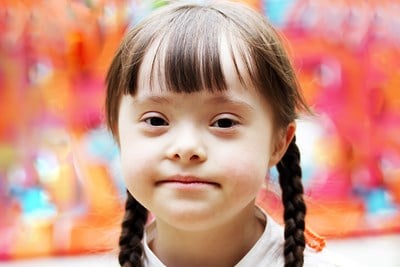Down syndrome is a genetic disorder that is caused by abnormal cell division and extra genetic material from chromosome 21. It is the most common genetic chromosomal disorder among children and leads to lifelong intellectual disabilities, developmental delays, and is also associated with some physical health conditions.
Down Syndrome Symptoms
The severity of the intellectual and developmental problems caused by Down syndrome will vary from mild to severe based on the individual. There are certain physical characteristics that tend to be indicative of Down syndrome in most children. The most common physical features include:
-
Small head
-
Shortened neck
-
Poor muscle tone
-
Flattened facial features
-
Short height
-
Unusually shaped or small ears
-
Protruding tongue
-
Broad, short hands with a single crease in the palm
-
Tiny white spots (known as Brushfield spots) on the irises of the eye
-
Upward slanting eyes
-
Excessive flexibility
-
Relatively short fingers and small hands and feet
Down Syndrome Causes
Abnormal cell division within chromosome 21 is responsible for the characteristic features and developmental problems that are associated with Down syndrome. There are three different genetic variations that can cause this to occur. These include:
-
Trisomy 21: This is the cause for approximately 95% of Down syndrome cases. Trisomy 21 occurs when a child has three copies of chromosome 21 in all cells, rather than the normal two copies. This is due to abnormal cell division during the development of the sperm or egg cell.
-
Mosaic Down syndrome: This is a rare form of Down syndrome that occurs when there is an extra copy of chromosome 21 in some cells but not others. The variation of normal and abnormal cells is caused by abnormal cell division after fertilization occurs.
-
Translocation Down syndrome: This type of Down syndrome occurs when part of chromosome 21 becomes attached to another chromosome before or at conception, leading to two copies of chromosome 21 with additional material also attached. This is the only form of Down syndrome that can be passed down from parent to child.
Down Syndrome Diagnosis
All pregnant women are recommended for both screening tests and diagnostic tests to check for Down syndrome in their children. Screening tests are used to indicate the likelihood of carrying a child with Down syndrome, while diagnostic tests are used to indicate whether or not your baby has Down syndrome. There are also tests that can be used after your baby is born to test for Down syndrome. The sooner your child is diagnosed, the more effective their treatment plan will be.
Down Syndrome Treatments
Children with Down syndrome must rely on a team of specialists that provide them with personalized care based on their specific needs. This team can include primary care physicians, pediatric cardiologists, pediatric gastroenterologists, pediatric endocrinologists, developmental pediatricians, pediatric neurologists, pediatric ENT specialists, pediatric ophthalmologists, audiologists, physical therapists, speech pathologists, and occupational therapists.
There are also early intervention programs that offer children with Down syndrome appropriate sensory, motor, and cognitive activities from a very early age. These programs can make a major difference in children with Down syndrome being able to realize their potential abilities and achieve a greater quality of life.




